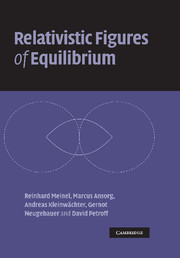Book contents
- Frontmatter
- Contents
- Preface
- Notation
- 1 Rotating fluid bodies in equilibrium: fundamental notions and equations
- 2 Analytical treatment of limiting cases
- 3 Numerical treatment of the general case
- 4 Remarks on stability and astrophysical relevance
- Appendix 1 A detailed look at the mass-shedding limit
- Appendix 2 Theta functions: definitions and relations
- Appendix 3 Multipole moments of the rotating disc of dust
- Appendix 4 The disc solution as a Bäcklund limit
- References
- Index
Appendix 1 - A detailed look at the mass-shedding limit
Published online by Cambridge University Press: 22 October 2009
- Frontmatter
- Contents
- Preface
- Notation
- 1 Rotating fluid bodies in equilibrium: fundamental notions and equations
- 2 Analytical treatment of limiting cases
- 3 Numerical treatment of the general case
- 4 Remarks on stability and astrophysical relevance
- Appendix 1 A detailed look at the mass-shedding limit
- Appendix 2 Theta functions: definitions and relations
- Appendix 3 Multipole moments of the rotating disc of dust
- Appendix 4 The disc solution as a Bäcklund limit
- References
- Index
Summary
The differentiability of functions at the mass-shedding limit
Since solutions to Poisson-like equations on domains containing corners are known to be non-analytic in general, it will come as no surprise to learn that the functions involved in describing a mass-shedding configuration are also not analytic. It is of interest, especially for the numerical methods used in this book, to be more precise. Ideally, we would be able to determine the asymptotic behaviour of the functions involved as one approaches a corner.We shall content ourselves in a first analysis, however, with determining which derivatives become singular.
The behaviour of solutions to Poisson-like equations on domains containing corners has been studied by Wigley (1970), Eisenstat (1974) and discussed in Birkhoff and Lynch (1984). In those analyses, it was always assumed that the domain boundaries are known whereas in our case, the (free) boundary arises from solving a global problem. Although we know that the cross-section of the surface of a mass-shedding body contains a corner, we do not know much, a priori, about the differentiability of its parametric representation ζb(ϱ).
Nonetheless, in order to study the behaviour of the Newtonian potential U, let us imagine that the global problem has been solved, that the surface is known, and that a cusp (i.e. mass shedding, cf. page 26) exists at the point ϱ = ϱ0.
- Type
- Chapter
- Information
- Relativistic Figures of Equilibrium , pp. 181 - 186Publisher: Cambridge University PressPrint publication year: 2008



